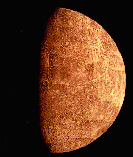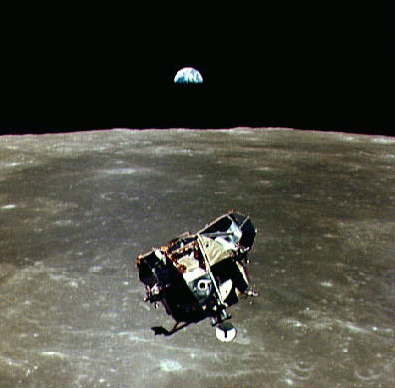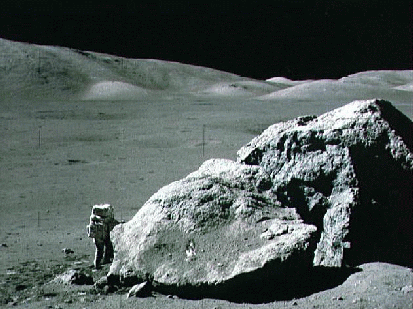 Earth's Interior --- | ---
Venus & Mars
Earth's Interior --- | ---
Venus & Mars

 Earth's Interior --- | ---
Venus & Mars
Earth's Interior --- | ---
Venus & Mars


Reading:
Chapter 4, 5-1 (ZG4)
 |
Key Question: | How did the Moon form and why is it so different from (or so similar to) the Earth? |
|---|---|---|
 |
Key Principle: | Cratering |
 |
Key Problem: | How large of an asteroid would have been needed to make the 100km crater Copernicus? |
 |
Key Quote: |
The final part of this course will be concerned with the properties of the planets found in our solar system, and what we can learn from them using the concepts learned in the first 2/3 of the course. There are alot of details about the individual planets that I will be unable to cover in the lecture, so you should read over carefully the relevant chapters of the textbook. The images and links provided below and on the upcoming web pages for the lecture notes will also be useful and interesting.
The final projects for this course will be the computer lab, and web-based lab on the Sun, and a group project planning an extrasolar planetary mission. I hope you find these educational and interesting.
Nearly all of what we know about solar system objects such as the Moon and Mercury was brought to us by the manned and unmanned space missions launched by the National Aeronautics and Space Administration (NASA). NASA has provided numerous images and educational resources on the Web.


In November 1969, Apollo 12 astronaut Pete Conrad took an image of astronaut Alan Bean as he inspected the Surveyor 3, which landed in the Ocean of Storms in April 1967. In the background is the astronauts Lunar Excursion Module. The surface sampler at Bean's left, the television camera he is touching, and several pieces of structural tubing were cut off and returned to Earth for a study of the long-term effects of the Moon's environment on the spacecraft.
A view of the north polar region of the Moon was obtained by Galileo's camera during the spacecraft's flyby of the Earth-Moon system on December 7 and 8, 1992. The north pole is to the lower right of the image. The view in the upper left is toward the horizon across the volcanic lava plains of Mare Imbrium. The prominent crater with the central peak is Pythagoras, an impact crater some 130 kilometers (80 miles) in diameter. The image was taken at a distance of 121,000 kilometers (75,000 miles) from the Moon through the violet filter of Galileo's imaging system. According to team scientists, the viewing geometry provided by the spacecraft's pass over the north pole and the low sun-angle illumination provide a unique opportunity to assess the geologic relationships among the smooth plains, cratered terrain and impact ejecta deposits in this region of the Moon. JPL manages the Galileo Project for NASA's Office of Space Science and Applications.
A mosaic picture of the Moon was compiled from 18 images taken with a green filter by Galileo's imaging system during the spacecraft's flyby on December 7, 1992, some 11 hours before its Earth flyby at 1509 UTC (7:09 a.m. Pacific Standard Time) December 8. The north polar region is near the top part of the mosaic, which also shows Mare Imbrium, the dark area on the left; Mare Serenitatis at center; and Mare Crisium, the circular dark area to the right. Bright crater rim and ray deposits are from Copernicus, an impact crater 96 kilometers (60 miles) in diameter. Computer processing has exaggerated the brightness of poorly illuminated features near the day/night terminator in the polar regions, giving a false impression of high reflectivity there.
A false-color mosaic was constructed from a series of 53 images taken through three spectral filters by Galileo's imaging system as the spacecraft flew over the northern regions of the Moon on December 7, 1992. The part of the Moon vlsible from Earth is on the left side in this view. The color mosaic shows compositional variations in parts of the Moon's northern hemisphere. Bright pinkish areas are highlands materials, such as those surrounding the oval lava-filled Crisium impact basin toward the bottom of the picture. B1ue to orange shades indicate volcanic lava flows. To the left of Crisium, the dark blue Mare Tranquillitatis is richer in titanium than the green and orange maria above it. Thin mineral-rich soils associated with relatively recent impacts are represented by light blue colors; the youngest craters have prominent blue rays extending from them.
The digital image processing was done by DLR the German aerospace research establishment near Munich, an international collaborator in the Galileo mission. The Galileo project, whose primary mission is the exploration of the Jupiter system in 1995-97, is managed for NASA's Office of Space Science and Applications by the Jet Propulsion Laboratory.
For more information on the Moon:

There were nine Apollo manned missions to the Moon. Nearly 400 kg of lunar samples were returned to Earth by the astronauts, providing us with vital information about lunar composition and history. Above we see geologist astronaut Harrison Schmitt exploring a lunar boulder during the Apollo 17 mission.
For extensive information on the Apollo Program, see the Kennedy Space Center's Apollo Archive. A site devoted to the Moon is the Goddard Space Flight Center's Lunar Exploration Page.

Mariner 10 used the Jet Propulsion Laboratory's basic Mariner design modified for a flight inward toward the Sun. The spacecraft weighed 503 kilograms (1,108 pounds), including 29 kilograms (64 pounds) of fuel and 30 kilograms (66 pounds) associated with the adapter between the spacecraft and the Centaur upper stage launch vehicle. Mariner 10's body was 1.39 meters (54 1/2 inches) wide and each solar panel was 2.7 meters (106 inches) long. The scientific experiments carried by the spacecraft were two television cameras, an infrared radiometer, extreme ultraviolet spectrometer, airglow instrument, magnetometer, plasma science, charged-particle telescope and radio science. Mariner 10 was launched in November 1973 and flew by Venus in January 1974. It encountered Mercury three times, in March and September of 1974 and in March 1975.
The photomosaic of Mercury was constructed of 18 photos taken at 42 second intervals by Mariner 10 six hours after the spacecraft flew past the planet on March 29, 1974. The north pole is at the top and the equator extends from left to right about two third down from the top. A large, circular basin, about 1,300 kilometers (800 miles) in diameter, is emerging from the dayŠnight terminator at left center. Bright rayed craters are prominent in this view of Mercury. One such ray seems to join in both east west and north south directions. Taken from a distance of about 210,000 kilometers (130,000 miles), the pictures were computer enhanced at the Jet Propulsion Laboratory.
For more information on Mercury:
 Prev Lecture ---
Prev Lecture ---
 Next Lecture ---
Next Lecture ---
 Astr11 Index ---
Astr11 Index ---
 Astr11 Home
Astr11 Home
smyers@nrao.edu Steven T. Myers